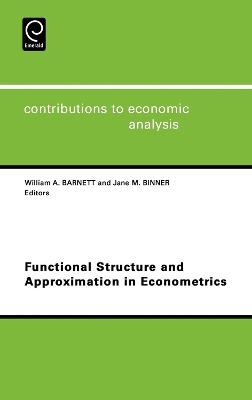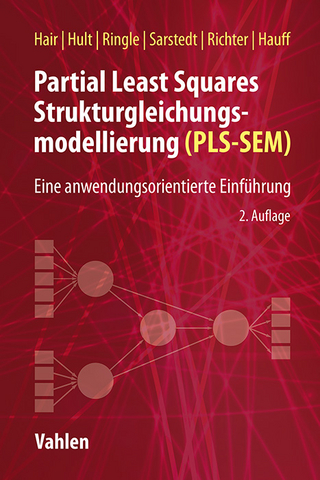
Functional Structure and Approximation in Econometrics
Elsevier Science Ltd (Verlag)
978-0-444-50861-4 (ISBN)
- Lieferbar (Termin unbekannt)
- Versandkostenfrei innerhalb Deutschlands
- Auch auf Rechnung
- Verfügbarkeit in der Filiale vor Ort prüfen
- Artikel merken
Economic theory defines and constrains admissible functional form and functional structure throughout the economy. Constraints on behavioral functions of individual economic agents and on the recursive nesting of those behavioral functions often are derived directly from economic theory. Theoretically implied constraints on the properties of equilibrium stochastic solution paths also are common, although are less directly derived. In both cases, the restrictions on relevant function spaces have implications for econometric modeling and for the choice of hypotheses to be tested and potentially imposed. This book contains state-of-the-art cumulative research and results on functional structure, approximation, and estimation: for (1) individual economic agents, (2) aggregation over those agents, and (3) equilibrium solution stochastic processes. A: Functional Structure Modeling, Aggregation, and Estimation. Over the past 25 years, William Barnett, who is a coeditor of this volume, has advanced the state of the art of this subject in many directions. He has contributed many new modeling and inference approaches, such as the Laurent series flexible functional form approach, the Muntz-Szatz series seminonparametric approach, the generalized hypocycloidal utility tree approach, and an aggregated convergence approach within the space of stochastic differential equations. Many of Barnett's innovations contain the earlier Taylor series and CES approaches as nested special cases. He also has contributed extensively to the literature on aggregation over approximating specifications in econometrics, as well as to aggregation over economic agents and goods in economic theory. In addition, his work in those areas has motivated new approaches by others, such as the generalized symmetric Barnett approach originated by Diewert and Wales (1987). Part 1 of this book contains Barnett's contributions to functional structure modeling and estimation for consumers, while Part 2 contains his contributions on those subjects for firms. B: Statistical Theory. Barnett's contributions to statistical theory provide much of the asymptotic statistical theory needed to apply econometric inference procedures to the literature on economic functional structure and approximation. His contributions to the relevant statistical theory include discovery of the measure theoretic foundations for confidence regions in sampling theoretic statistics and the derivation of the asymptotic theory for joint maximum likelihood inference with closed-form systemwide models. He originated a multivariate extension of the Kolmogorov-Smirnov test to permit testing the disturbances of an equation system for multivariate normality. Part 3 contains relevant results in statistical theory. C: Nonlinear Time Series. Analogous approximation and function space problems arise in time series approaches. A Volterra expansion in the time domain with a finite number of terms cannot span the space of possible time-series solution processes from the state space structures of economic theory. Hence when sample size is finite, all structural and time-series approximating specifications, whether dynamic or static, drive an unavoidable wedge between econometrics and economic theory. No easy solution exists to this inherently deep problem in econometric modeling and testing. In the time series literature, Barnett has designed and run a competition among tests for nonlinear and chaotic structure. The purpose was to investigate paradoxes that arose in that literature following his publication of findings of nonlinearity and chaos in some economic time series. The literature on modeling and filtering out linear structure from time series is now highly advanced. But many unsolved problems remain in the literature on modeling or filtering out various forms of nonlinear structure from time series. The results of Barnett's competition have cast much needed light on those problems and the relative properties of the various available competing approaches. Contributions to time series modeling and inference in the time domain and the frequency domain are provided in Part 4.
Abbreviated. Preface (W.E. Diewert). Editor's introduction to volume (W.A. Barnett, J. Binner). Part 1: Structural function system specification: consumer demand. Section 1.1: Editors' overview of part 1 (W.A. Barnett, J. Binner). Section 1.2: The differential approach. Section 1.3: The locally flexible functional form approach. 1.4: The globally flexible functional form approach. Section 1.5: Recursively nested, homothetic, and inverse function structures. Part 2: Structural function system specification: production. Section 2.1 Editors' overview of part 2. Section 2.2 Production by firms. Section 2.3: Household production. Part 3: Relevant econometric theory. Section 3.1: Editors' overview of part 3. Section 3.2: Asymptotic statistical theory. Part 4: Nonlinear structure in time series. Section 4.1: Editors' overview of part 4. Section 4.2: Chaos. Section 4.3: Frequency domain methods. Section 4.4: A competition.
| Erscheint lt. Verlag | 2.7.2004 |
|---|---|
| Reihe/Serie | Contributions to Economic Analysis |
| Verlagsort | Kidlington |
| Sprache | englisch |
| Maße | 156 x 234 mm |
| Gewicht | 1168 g |
| Themenwelt | Wirtschaft ► Volkswirtschaftslehre ► Ökonometrie |
| ISBN-10 | 0-444-50861-9 / 0444508619 |
| ISBN-13 | 978-0-444-50861-4 / 9780444508614 |
| Zustand | Neuware |
| Haben Sie eine Frage zum Produkt? |
aus dem Bereich


